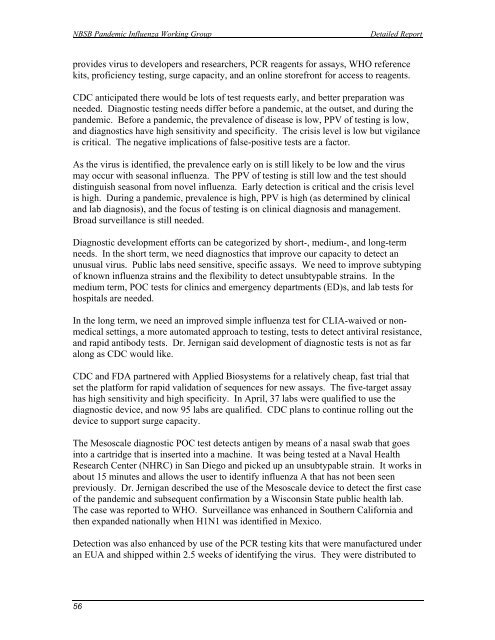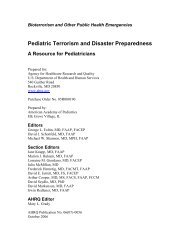H1N1 COUNTERMEASURES STRATEGY AND ... - PHE Home
H1N1 COUNTERMEASURES STRATEGY AND ... - PHE Home
H1N1 COUNTERMEASURES STRATEGY AND ... - PHE Home
You also want an ePaper? Increase the reach of your titles
YUMPU automatically turns print PDFs into web optimized ePapers that Google loves.
NBSB Pandemic Influenza Working Group<br />
Detailed Report<br />
provides virus to developers and researchers, PCR reagents for assays, WHO reference<br />
kits, proficiency testing, surge capacity, and an online storefront for access to reagents.<br />
CDC anticipated there would be lots of test requests early, and better preparation was<br />
needed. Diagnostic testing needs differ before a pandemic, at the outset, and during the<br />
pandemic. Before a pandemic, the prevalence of disease is low, PPV of testing is low,<br />
and diagnostics have high sensitivity and specificity. The crisis level is low but vigilance<br />
is critical. The negative implications of false-positive tests are a factor.<br />
As the virus is identified, the prevalence early on is still likely to be low and the virus<br />
may occur with seasonal influenza. The PPV of testing is still low and the test should<br />
distinguish seasonal from novel influenza. Early detection is critical and the crisis level<br />
is high. During a pandemic, prevalence is high, PPV is high (as determined by clinical<br />
and lab diagnosis), and the focus of testing is on clinical diagnosis and management.<br />
Broad surveillance is still needed.<br />
Diagnostic development efforts can be categorized by short-, medium-, and long-term<br />
needs. In the short term, we need diagnostics that improve our capacity to detect an<br />
unusual virus. Public labs need sensitive, specific assays. We need to improve subtyping<br />
of known influenza strains and the flexibility to detect unsubtypable strains. In the<br />
medium term, POC tests for clinics and emergency departments (ED)s, and lab tests for<br />
hospitals are needed.<br />
In the long term, we need an improved simple influenza test for CLIA-waived or nonmedical<br />
settings, a more automated approach to testing, tests to detect antiviral resistance,<br />
and rapid antibody tests. Dr. Jernigan said development of diagnostic tests is not as far<br />
along as CDC would like.<br />
CDC and FDA partnered with Applied Biosystems for a relatively cheap, fast trial that<br />
set the platform for rapid validation of sequences for new assays. The five-target assay<br />
has high sensitivity and high specificity. In April, 37 labs were qualified to use the<br />
diagnostic device, and now 95 labs are qualified. CDC plans to continue rolling out the<br />
device to support surge capacity.<br />
The Mesoscale diagnostic POC test detects antigen by means of a nasal swab that goes<br />
into a cartridge that is inserted into a machine. It was being tested at a Naval Health<br />
Research Center (NHRC) in San Diego and picked up an unsubtypable strain. It works in<br />
about 15 minutes and allows the user to identify influenza A that has not been seen<br />
previously. Dr. Jernigan described the use of the Mesoscale device to detect the first case<br />
of the pandemic and subsequent confirmation by a Wisconsin State public health lab.<br />
The case was reported to WHO. Surveillance was enhanced in Southern California and<br />
then expanded nationally when <strong>H1N1</strong> was identified in Mexico.<br />
Detection was also enhanced by use of the PCR testing kits that were manufactured under<br />
an EUA and shipped within 2.5 weeks of identifying the virus. They were distributed to<br />
56
















